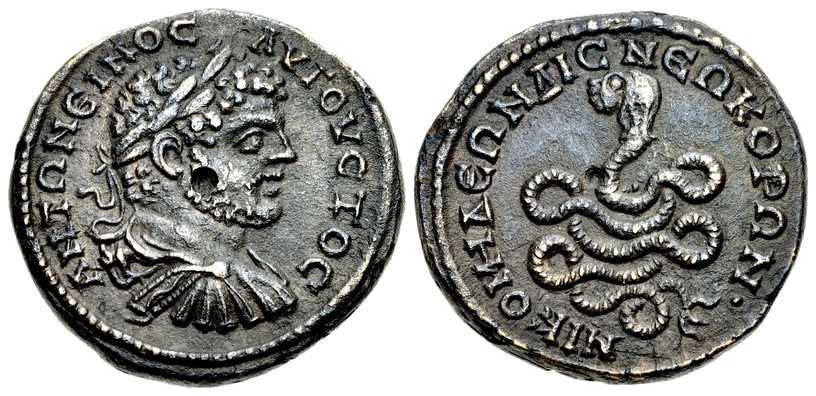| 198 AD - 217 AD |
Bithynia Nicomedia
Caracalla
Βιθυνία Νικομήδεια Καρακάλλας
Βιθυνία Νικομήδεια Καρακάλλας
| AE 27 |
SHH
v4405 |
 |
| Parameter Obverse Reverse Notes Reference Provenance |
12.12 g 12 mm 1:00
o'clock VF centering + / + Lureate draped and cuirassed bust of Caracalla right; ΑΝΤΩΝΕΙΝΟC / ΑVΓΟVCΤΟC clockwise around; border of dots. The serpent Glycon coiled to left, with human head with long hair; ΝΙΚΟΜΗΔΕΩΝ ΔΙC ΝΕΩΚΟΡΩΝ clockwise around; border of dots. This highly interesting
coin depicts the deity Glycon, whose cult was the subject of Lucian of
Samosata’s scathing Alexander the False Prophet. Lucian (ca. AD
125-after 180) describes the cult as a fraud created by a medicine man
named Alexander (ca. AD 105-170). According to the author, Alexander
decided there was a fortune to be made divining the future, so he
hatched a plan: the swindler planted a snake within the foundations of
a new temple to Asclepius at Abonuteichus in Paphlagonia, and convinced
the superstitious residents that its appearance fulfilled a prophecy
that Asclepius would come to earth in the form of a serpent by the name
of Glycon. Alexander is said to have outfitted the large serpent with a
puppet head – the mouth of which he would move by pulling strings –
that was topped with a long, blonde wig, a description that fits well
with the tressed snake seen on our coin. We are told that worshippers
of Glycon could visit the serpent and have their fortunes read…for a
hefty sum paid to the puppet-master Alexander.
RGAM 227Despite Lucian’s scandalous accusations, the cult of Glycon spread dramatically during the 2nd century. By the time of Caracalla, we have evidence that Glycon was worshipped from the Danube to the eastern limits of the empire. [CNG 103/569] Ex CNG 103/569, 14.9.2016 |